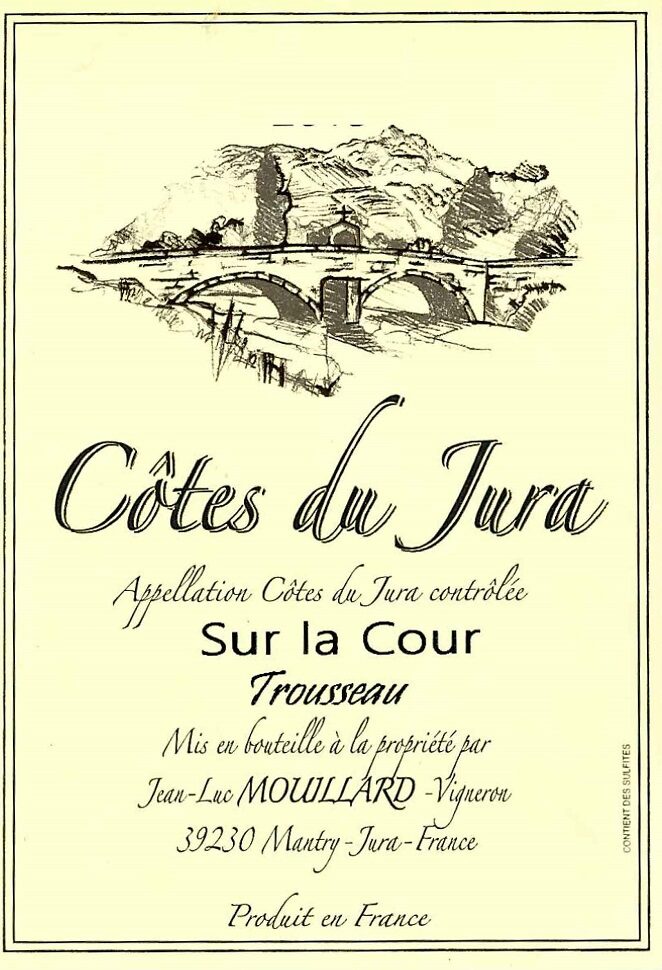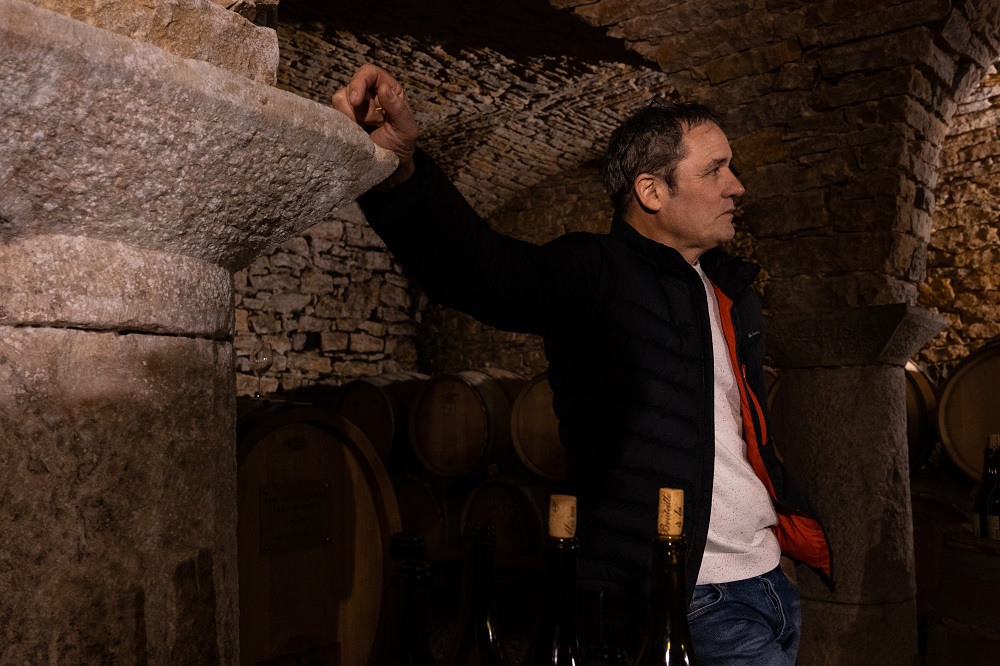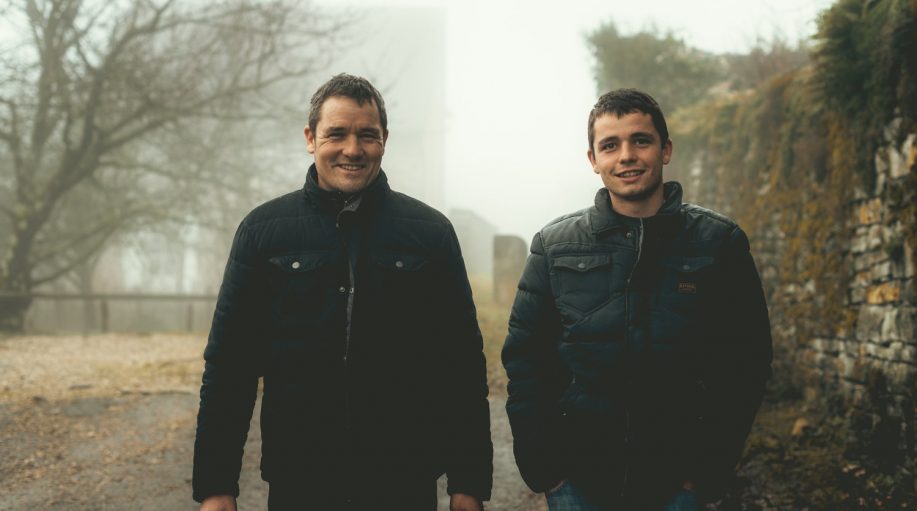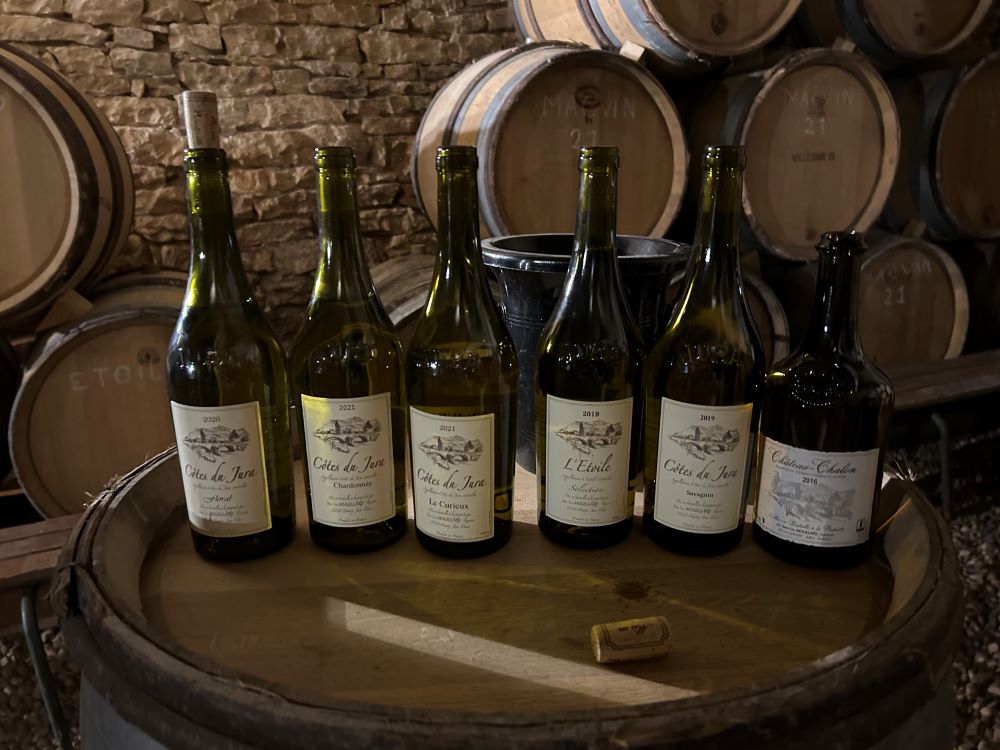Domaine Jean-Luc Mouillard, Jura

| Country & Region | France, Jura |
| Appellation(s) | Côtes du Jura, L'Etoile, and Château-Chalon |
| Producer | the Mouillard family |
| Founded | Jean-Luc Mouillard established the domain in 1991. |
| Website | www.domainemouillard.com |
Wines that are firmly rooted but spontaneous, attractive and accessible.
—Pierre Citerne, Revue du Vin de France, July 2023
Another producer whose wines were most impressive was Jean-Luc Mouillard.
—John Gilman, View from the Cellar, June 2021
Jean-Luc Mouillard was born in Nevy-sur-Seille at the foot of the oft-photographed Château-Chalon. The château has morphed into a village as well as into Jura’s most respected appellation for vin jaune, and it occupies the top of a huge limestone outcropping. Nevy-sur-Seille, as the name suggests, sits far below on the valley floor along side of the small Seille River. An old stone bridge crosses the Seille at Nevy, and it’s this bridge that graces the labels of Jean-Luc’s wines.

Jean-Luc grew up on the family’s dairy farm, which happened to have a few vineyard parcels on the side whose harvest was sold to the local co-op. After enology school, he established Domaine Jean-Luc Mouillard in 1991, renting several parcels and planting several others. Today he farms twenty-seven acres of vines (up from the twenty stated on old back labels that may still be seen on bottles) in three appellations: Côtes du Jura, L’Etoile, and Château-Chalon, and normally 80% of his production is in white wine. The bulk of the vines are in the AOC of Côtes du Jura for Chardonnay, Pinot Noir, Poulsard and Trousseau, and all of his vines grow right around 1,000 feet in elevation. The farming ethic had been one of lutte raisonnée, or pragmatically sustainable (the use of herbicides, pesticides and chemical fertilizers were abandoned many years previously). Then the domaine embarked on organic farming in 2020 and became certified in 2023.

In 1997 Jean-Luc moved north from Nevy-sur-Seille to the village of Mantry upon buying a sixteenth-century house that originally served as a stagecoach stop. The motivation was the building’s stone cellar, an arched underground affair that became a place of beauty once Jean-Luc stripped off all of the stucco that had been applied to the stone at a later date. Here is where he ages wine in barrel. In 2005 he constructed a one-story building across the street for his fermentations, and in 2014 he built a facility to house a bottling line and to store bottled wine.

Thus, through dint of focus and hard work, Jean-Luc has created a serious artisan domaine that produces up to 55,000 bottles or 9,000 six-pack cases per year. His wife Annie runs the office and their son Mathieu has joined the domaine. Mathieu did an internship in the Mâconnais and then at Pierre Gaillard’s domaine in Faugères following his enological studies, and officially started with his father in 2018.

The Jura is sandwiched between Switzerland and Burgundy, and its vineyard area is the first upland between the Bresse Plain and the Jura Mountains. The lower slopes have more clay to go with marl; the higher slopes have more limestone, much like Burgundy’s Côte d’Or on the other side of the vast plain (unlike Burgundy, however, the Jura’s vineyards have a treasure trove of tiny star-shaped fossils, scattered like star dust upon the ground.). The influence of the Alps ensures that Jura’s climate is decidedly more continental than Burgundy’s, and winters can be quite cold. Vines are trained high for added protection against frost. Harvest typically runs well into October.

This is an ancient grape-growing region whose wine was referenced in 80 AD by Pliny the Younger. The early 19th century supported close to 50,000 acres of vines. Largely because of the phylloxera epidemic, the total today is some 4,700 acres (2014 acreage census) in an appellation that allows for as much as 27,000 acres to be planted. The earlier century supported a far greater diversity of vines too—42 different kinds, according to one count—whereas today five varieties dominate. Chardonnay is the most important at 43% of the total vineyard surface, and came from Burgundy with its sibling Pinot Noir as long ago as the 10th century. Savagnin, a distinctive wine prized for vin jaune, accounts for 22% of the vineyards; Poulsard, aka Ploussard, adds up to 14%; Pinot Noir for 13%; and Trousseau for 8% (these varietal percentages come from a census taken in 2000).

Thanks to Jeff Bramwell for the fossil shot and the photo of Jean-Luc and Mathieu. Thanks to Evan Hansen of the Selden Standard in Detroit for the photo of Jean-Luc.
The Wines
| Wine | Blend | Description |
|---|---|---|
| Crémant du Jura | Chardonnay | This is now entirely made in house at the domaine (rather than, as is commonly done, at a facility specializing in sparkling wine production). It ages for an average of 18 months on the lees in bottle before disgorgement, and the wine is disgorged upon order. Dosage is in the range of 6 grams per liter. Production averages 750 six-packs. Tech sheet here. |
| Côtes du Jura Chardonnay (Bas de la Chaux) | Chardonnay | Years back Jean-Luc used three parcels to make this wine, but now in productive years it comes from a single parcel named La Chaux. The parcel totals three acres, and much of it is on a steep hillside that must be worked by hand. The initial fermentation takes place in steel with the malo taking place during aging in older barrels, and both fermentations are normally spontaneous (as with all their still wines). The wine is a product of Jura’s alpine foothills—their elevation and their limestone—making for a delicious combination of elegance and minerality. Production averages around 600 cases (note that in short vintages like 2017 and 2021, the domaine blends Chardonnay from other parcels to have enough volume, and the name of the plot is taken off the front label). Tech sheet here. |
| Floral | Chardonnay with Savagnin | Another ouillé wine, i.e., one that isn't purposely exposed to air for an extended time during élevage, Floral is composed of Chardonnay with around 10% Savagnin. The exact percentages fluctuate according to the harvest, but the aim is always to have a fresh, vibrant wine. This is made entirely in tank and production averages 700 cases. Tech sheet here. |
| Côtes du Jura Le Curieux | Savagnin | An ouillé wine--from oeil, French for eye, and refers to wines that are topped off up to the eye of the barrel to be protected from oxidation during élevage —standard just about everywhere except in Jura, where the tradition has been to work with oxidative wines. The grape is Jura’s own distinctive Savagnin, commonly used to make the Sherry-like Vin Jaune and the sweet, concentrated Vin de Paille. This version is one of the new wave of wines coming out of these Alpine foothills. This is raised primarily in older wood for an élevage of 16 months. A productive year sees 4,500 bottles. Tech sheet here. |
| Côtes du Jura Trousseau Sur La Cour | Trousseau | One parcel of nearly 3 acres in their commune of Mantry, where you can find the star fossils that are in the photo in the profile above. Trousseau is a Jura native and at some point in its history migrated to Portugal, where it is known as Bastardo. The Mouillard rendition is a lightly-colored wine of notably full, limestony flavors. Lighter years see this wine aged entirely in tank while riper years can see barrel ageing. Low yielding years can result in this being blended with Poulsard and Pinot Noir to make a red in sufficient volume named Rubis. In abundant years, production of Trousseau can reach 375 cases. Tech sheet here. |
| Côtes du Jura Pinot Noir | Pinot Noir | This comes from two parcels totaling well under two acres and is raised in older barrels. Lightly colored and easily--painfully easily-- underestimated by the uninitiated. Production averages 125 cases. Tech sheet here. |
| L'Etoile Sélection | 60% Savagnin, 40% Chardonnay | The domaine farms 5 acres in AOP Etoile. The Sélection bottling is a traditional Jura made with Savagnin and Chardonnay, both made sous voile, or under the veil of yeast that forms across wine in a barrel that intentionally is not topped off, and then blended and bottled. Tech sheet here. |
| Macvin | 50% Chardonnay, 50% Savagnin | Macvin, shortened for marc-vin, is the Jura's version of Pineau de Charentes (Cognac), Floc de Gascogne (Armagnac), or Ratafia (Burgundy), in which eau de vie is added to grape juice (sometimes partially fermented into wine, but in Mouillard's case it's simply grape juice) to arrest any ferments and preserve the immediate fruit of the juice. The marc comes from Jean-Luc's grape pomace, which he takes to a distiller to distill into eau de vie. Subsequently, the Macvin is aged in older demi-muids for more or less two years before bottling. |